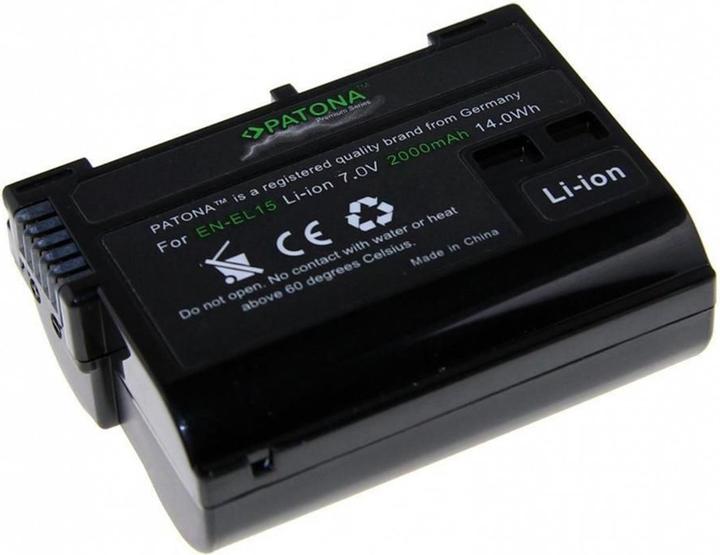

Batteries and chargers: Favourable alternatives from Patona
It's an old phenomenon: original batteries from the manufacturer are relatively expensive compared to the much cheaper replacement batteries from third-party manufacturers. The question arises as to whether you really need to go for the original. Are there any differences at all?
You can also get inexpensive batteries from third-party manufacturers from us. The manufacturer of these batteries is Patona International S.L.U., based in Germany. We also offer chargers from this company. These are also much cheaper than the original chargers.
There are two common explanations as to why the original products are so much more expensive.
Firstly, manufacturers add a hefty margin because they know that customers pay less attention to the price of accessories than they do to the main product (in this case, the camera). This is understandable, as the margins on electronics are usually brutally low. But if that were the only reason, you could go for the cheaper product without hesitation.
Secondly, there are indeed differences between original parts and goods from third-party manufacturers.
A closer look at the Patona batteries
Editorial colleague Kevin Hofer and I spontaneously stocked up on spare batteries for our cameras. It doesn't cost anything. Kevin has the following battery for Sony cameras
.
In terms of specs, the cheap batteries are at least equivalent. The Patona battery for my Nikon camera is of type EN-EL15b, so it can be charged in a Nikon Z with USB. At 2000 mAh, it has slightly more capacity than the original battery with its 1900 mAh. According to the technical specifications, the battery for Kevin's Sony camera is also slightly better at 1030 mAh than the original at 1020 mAh.

But is this information correct? I emptied both of Kevin's batteries (original and Patona battery) and measured how much current flows through when fully charged. With the original Sony battery, which is practically never used, it was 1804 mAh, with the Patona 1354 mAh. This means that the original battery stores significantly more power than the cheap battery, but even the latter holds more than stated.

I did not check how much these values change over time and how wide the spread of the individual specimens is. I rule out overcharging the batteries - the batteries were not even warm after charging.
I couldn't use the power meter on my Nikon D7500 because the charger doesn't work with USB. But I had to record over an hour of HD video and shoot 500 photos to get the Patona battery halfway empty. There is a point in the Nikon camera menu that shows the age of the battery. The camera correctly classifies the battery as new.

Conclusion: The cheap products are certainly usable as second batteries, even if they do not have the same capacity and service life as the original.
Are third-party chargers safe?
Kevin also bought a charger straight away. Not only because it costs next to nothing, but also because Sony doesn't supply a charger at all. The battery has to be charged in the camera itself, which means you can't charge one battery and use the camera with the other.
The Patona charger only has two contacts per battery, i.e. plus and minus for the current. However, the Sony charger and the batteries (also from Patona) have three contacts.

The additional contact can be used to transmit information about the battery, such as what type it is. Or it can be used to determine the temperature. This protects the battery from overheating.
Overcharging lithium-ion batteries is not without danger. Here is a video from EMPA (Swiss Federal Laboratories for Materials Science and Technology) in which a battery continues to be charged. It inflates, explodes and then burns.
Does this mean that your batteries will burst into flames if you charge them in a Patona charger and don't unplug them in time?
No. There are other methods to ensure that the battery is not overcharged. A charger can also monitor the voltage curve and the amount of current and deduce from this when the battery is full and charging needs to be stopped.
The product description of the charger states: "The built-in charging technology is microcontroller-controlled and prevents overcharging or overheating. It also automatically recognises the required voltage of the inserted battery."
We have opened the charger and can see that there is indeed a microcontroller inside. We didn't find out exactly what it does and how. But in principle, the voltage can also be measured with just two contacts and the curve can also be determined with the appropriate electronics.

There are strict safety regulations for the European market. A charger without effective overcharge protection would certainly not be awarded the CE seal. At best, the protection is not quite as precise, which would shorten the service life of a battery.
A good addition, but probably not a full replacement
Patona rechargeable batteries are not exactly the same as the original products. In our measurement, the original battery had significantly more charging capacity. However, the Patona batteries are usable and safe.
I also classify the chargers as safe. Although they only have two contacts instead of three, the internal electronics of the charger should reliably protect against overcharging.
I recommend using the original battery and, if available, the original charger that came with the camera whenever possible. Or charge the battery in the camera via USB. However, the Patona products are a good addition if you need a lot of power.
18 people like this article
My interest in IT and writing landed me in tech journalism early on (2000). I want to know how we can use technology without being used. Outside of the office, I’m a keen musician who makes up for lacking talent with excessive enthusiasm.





